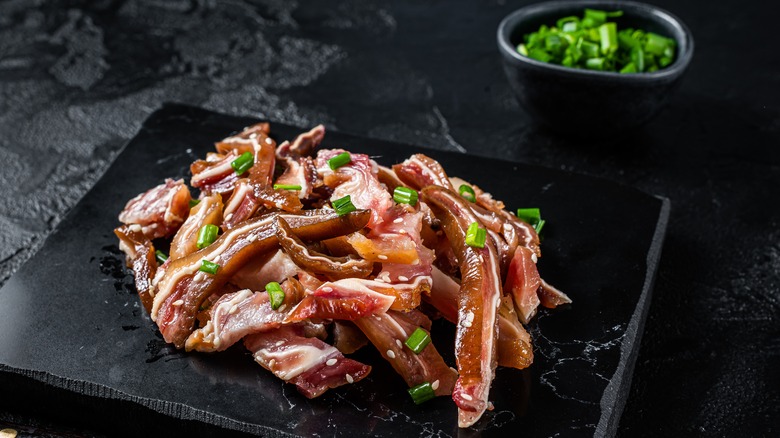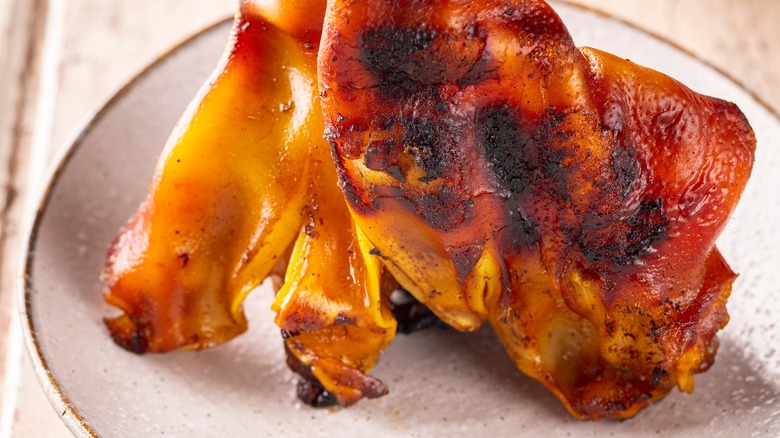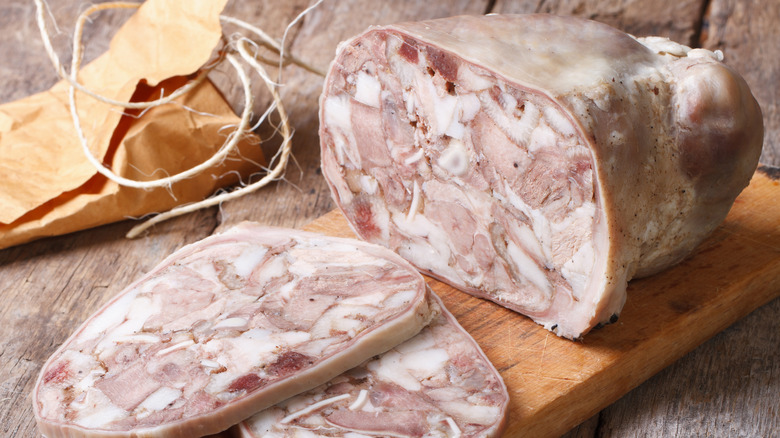The Overlooked Part Of The Pig That Fries Up Nicely
Among pork producers and agricultural organizations, you might come across the tagline "Everything but the Oink," often accompanied by an infographic (like this one from Animal Smart) detailing the numerous edible, industrial, and pharmaceutical products that are derived from pigs. In fact, Animal Smart writes that pigs provide a broader variety of these items than any other kind of livestock. So why are we mainly obsessed with bacon when the hog's got so much more to offer?
Pork bones can be used to make bone broth just like beef or poultry bones, or build the flavor foundation for an unforgettable split pea soup, and the leftover meat that falls off can be made into pork floss (via Instructables). Pork fat is the secret to rich tonkatsu ramen and rendered lard is a surprisingly versatile, mellow cooking fat. And of course, pork skin is an irresistible keto-friendly snack. But there's something you simply must try next time you reach for that skillet.
Yes, it's the ear
One pork cut that's becoming trendier lately is the ear. While it might appear that the contrary is true, pig ears are surprisingly present in world cuisine and Los Angeles Times reports that it's popular throughout Asia and Europe. There are cold preparations including head cheese, a terrine made with a boiled whole hog's head, and dishes like Chinese spicy pig ear salad, both of which celebrate the porcine taste and unique texture. But as the Times writes, pig ears are almost always served fried, fortunately, because frying is a shortcut to many a satisfied stomach.
Fried pig ears have been popping up as appetizers at bars and nosheries, a separate article from the Times explains, where the thinly-sliced, salty snacks are right at home alongside nibbles like nachos, and hot wings. LA Weekly explains that prep and presentation can vary — they can be puffed like pork rinds, cooked to extreme crunchiness, or boiled and strewn atop salad like Thai nam sod or French frisée aux lardons. Per LA Times, the eating experience is unabashedly porky, and juxtaposes soft and snappy, crispy and gummy textures that pair well with a few cold ones.
Other ways to cook pig ears
If you're feeling adventurous, try Food Network's crispy pickled pig ears with Alabama white sauce. This recipe can help you learn not only how to handle the offal cut but also how to do a pickle brine and an efficient deep fry, and make a less-common mayo-based form of barbecue sauce. Another recipe, Great British Chefs's crispy pig ears, features a caper tartar sauce made with nasturtiums — an edible flower — so you can enjoy two unfamiliar and unique ingredients in one very classy dish.
Another delicious and approachable way to enjoy pig ears is in tacos de oreja. L.A.TACO explains that for taco filling, the ears are slow-cooked but the cartilaginous part retains a little bit of rigidity, which you'll enjoy if you eat the joints of chicken wings. Los Angeles Times shared a Sichuan-inspired pig ear terrine that will add an intriguing dimension to your next charcuterie spread. Should you want to make these recipes, look for pig ears at farms, butchers, or stores with large meat selections. Eating and cooking with new and different ingredients challenges the eater — broadening their skill set and diversifying their palate.


